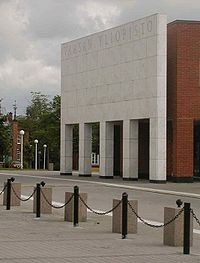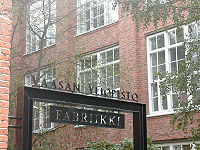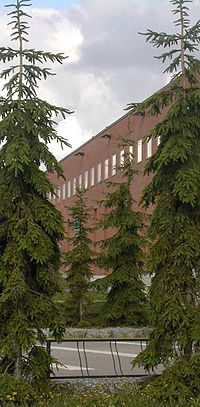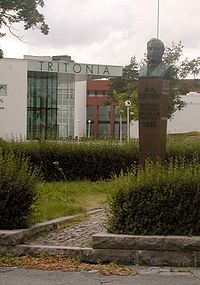
University of Vaasa
Encyclopedia
The University of Vaasa is a multidisciplinary, business-oriented university
in Vaasa
, Finland
. The campus
of the university is situated by the Gulf of Bothnia
adjacent to downtown
Vaasa. The university has evolved from a school of economics founded in 1968 to a university consisting of three faculties: Faculty of Business Studies, Faculty of Philosophy and Faculty of Technology. With its Faculty of Business Studies, also called the Vaasa School of Economics, University of Vaasa is one of the largest business universities in Finland. The university has 425 personnel which includes a teaching staff of 180 and 54 professors. Around 5000 students are currently studying in various degree programs at the university.






Faculty of Philosophy
Faculty of Technology
Faculty of Philosophy
Faculty of Technology
made the decision to establish a School of Economics and Business Administration in Vaasa, and so Vaasa got its first institution of higher education which the region of Vaasa had worked for since the 1940's. The very next year the first students started their studies; 90 business and 60 correspondence students. The first principal to be chosen for the school was Tryggve Saxén and the first vice principal was Mauri Palomäki, who later would become the longest serving principal the school has seen so far. The lectures were first held in a yard building of Vaasa Commercial College in Raastuvankatu street, but in its second year the school moved into the whole house as the commercial college moved to a new building.
In 1977 the school became a state institution along with all other academic institutions in Finland.
In 1980 education in Humanities
(languages) began and so the school became a "School of higher education" (in Finland the term is "Korkeakoulu". In order to be called a University, or "Yliopisto", in Finland at least four faculties are needed). In 1983 studies in the Social Sciences
began and in 1990 Technology studies began in connection with Helsinki University of Technology
. In 1992 the school was organised into four faculties; The Humanities, Business Administration, Accounting and Industrial Management, and Social Sciences, so that it could finally officially be labelled a University. In 1994 the school moved into its new premises on Palosaari.
who planned most of Vaasas public buildings in 1860. The part of the university placed in the old mill is called "Fabriikki" (En: Factory). There is also the academic library of Tritonia, which the university shares with the other academic institutions in the city, and the laboratory of Technobothnia, which is shared with the city's two universities of applied sciences. The whole campus is near the waterfront and surrounded by park areas. It is sometimes called the most beautiful campus in Finland.
University
A university is an institution of higher education and research, which grants academic degrees in a variety of subjects. A university is an organisation that provides both undergraduate education and postgraduate education...
in Vaasa
Vaasa
Vaasa is a city on the west coast of Finland. It received its charter in 1606, during the reign of Charles IX of Sweden and is named after the Royal House of Vasa...
, Finland
Finland
Finland , officially the Republic of Finland, is a Nordic country situated in the Fennoscandian region of Northern Europe. It is bordered by Sweden in the west, Norway in the north and Russia in the east, while Estonia lies to its south across the Gulf of Finland.Around 5.4 million people reside...
. The campus
Campus
A campus is traditionally the land on which a college or university and related institutional buildings are situated. Usually a campus includes libraries, lecture halls, residence halls and park-like settings...
of the university is situated by the Gulf of Bothnia
Gulf of Bothnia
The Gulf of Bothnia is the northernmost arm of the Baltic Sea. It is situated between Finland's west coast and Sweden's east coast. In the south of the gulf lie the Åland Islands, between the Sea of Åland and the Archipelago Sea.-Name:...
adjacent to downtown
Downtown
Downtown is a term primarily used in North America by English speakers to refer to a city's core or central business district ....
Vaasa. The university has evolved from a school of economics founded in 1968 to a university consisting of three faculties: Faculty of Business Studies, Faculty of Philosophy and Faculty of Technology. With its Faculty of Business Studies, also called the Vaasa School of Economics, University of Vaasa is one of the largest business universities in Finland. The university has 425 personnel which includes a teaching staff of 180 and 54 professors. Around 5000 students are currently studying in various degree programs at the university.






Faculties and Departments
Faculty of Business Studies- Accounting and Finance
- Business Law and Economics
- Management
- Marketing
Faculty of Philosophy
- Languages and Communication
- Communication Studies
- English
- German Language and Literature
- Modern Finnish and Translation
- Scandinavian Languages
- French Language
- Russian Language
- Administrative Sciences
- Philosophy
- Public Law
- Public Management
- Regional Studies
- Social and Health Administration
- Sociology
Faculty of Technology
- Mathematics and Statistics
- Electrical Engineering and Energy Technology
- Computer Science and Telecommunications Engineering
- Production
Key Areas of Research
Faculty of Business Studies- Business Finance and Financial Markets, Financial Statement Analysis, Management Accounting
- Consumer Behaviour, Product Research and Development
- Entrepreneurship, Leadership, Economic Growth and Profitability of SMEs
- International Economics and European Integration, Internationalization of SMEs
- Legalities of Trade with Eastern Europe and CIS, Data Communications Law
Faculty of Philosophy
- Administrative Sciences
- Comparative Public Policy
- Public Management, Evaluation
- The Welfare State and the Profitability of Public Services
- Languages and Communication
- Culture and Literature, Intercultural Communication
- Language for Special Purposes (LSP)
- Multilingualism (Language Immersion), Translation
- Multimedia Systems and Technical Communication
Faculty of Technology
- Dynamic Mathematical Modelling
- Energy Technology and Economics
- New Information Processing Methods
History
In 1966 the Council of StateCouncil of State
The Council of State is a unique governmental body in a country or subdivision thereoff, though its nature may range from the formal name for the cabinet to a non-executive advisory body surrounding a head of state. It is sometimes regarded as the equivalent of a privy council.-Modern:*Belgian...
made the decision to establish a School of Economics and Business Administration in Vaasa, and so Vaasa got its first institution of higher education which the region of Vaasa had worked for since the 1940's. The very next year the first students started their studies; 90 business and 60 correspondence students. The first principal to be chosen for the school was Tryggve Saxén and the first vice principal was Mauri Palomäki, who later would become the longest serving principal the school has seen so far. The lectures were first held in a yard building of Vaasa Commercial College in Raastuvankatu street, but in its second year the school moved into the whole house as the commercial college moved to a new building.
In 1977 the school became a state institution along with all other academic institutions in Finland.
In 1980 education in Humanities
Humanities
The humanities are academic disciplines that study the human condition, using methods that are primarily analytical, critical, or speculative, as distinguished from the mainly empirical approaches of the natural sciences....
(languages) began and so the school became a "School of higher education" (in Finland the term is "Korkeakoulu". In order to be called a University, or "Yliopisto", in Finland at least four faculties are needed). In 1983 studies in the Social Sciences
Social sciences
Social science is the field of study concerned with society. "Social science" is commonly used as an umbrella term to refer to a plurality of fields outside of the natural sciences usually exclusive of the administrative or managerial sciences...
began and in 1990 Technology studies began in connection with Helsinki University of Technology
Helsinki University of Technology
Aalto University School of Science and Technology , was the temporary name for Helsinki University of Technology during the process of forming the Aalto University...
. In 1992 the school was organised into four faculties; The Humanities, Business Administration, Accounting and Industrial Management, and Social Sciences, so that it could finally officially be labelled a University. In 1994 the school moved into its new premises on Palosaari.
Campus
The university can be found in the neighbourhood of Palosaari beside the city's old cotton mill, which also houses part of the university. Each building has its own name, like the main building of "Tervahovi" (En: Pinetar Court) and the governing building of "Luotsi" (En: Pilot). These buildings were finished in 1994 and planned in the spirit of the former county architect Carl Axel SetterbergCarl Axel Setterberg
Carl Axel Setterberg was an architect from Bogsta parish in Södermanland, Sweden. He studied to become an architect at the Swedish Art Academy in Stockholm from 1834-1841. In May 1841, he got a job as building contractor in Gävleborg province, where he worked the following ten years...
who planned most of Vaasas public buildings in 1860. The part of the university placed in the old mill is called "Fabriikki" (En: Factory). There is also the academic library of Tritonia, which the university shares with the other academic institutions in the city, and the laboratory of Technobothnia, which is shared with the city's two universities of applied sciences. The whole campus is near the waterfront and surrounded by park areas. It is sometimes called the most beautiful campus in Finland.
Services
- Levón Institute - Centre for Continuing Education and Research
- Tritonia - Academic Library, Vaasa
- Technobotnia - Research Centre
- VaasaEMG - Nordic Centre for Expertise in Energy and Utilities Marketing
- Vaasan Yliopiston Ylioppilaskunta - Student Union of Vaasa University

